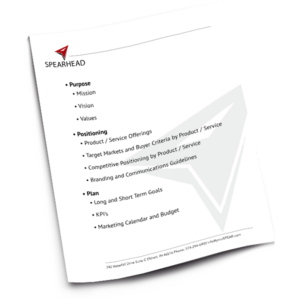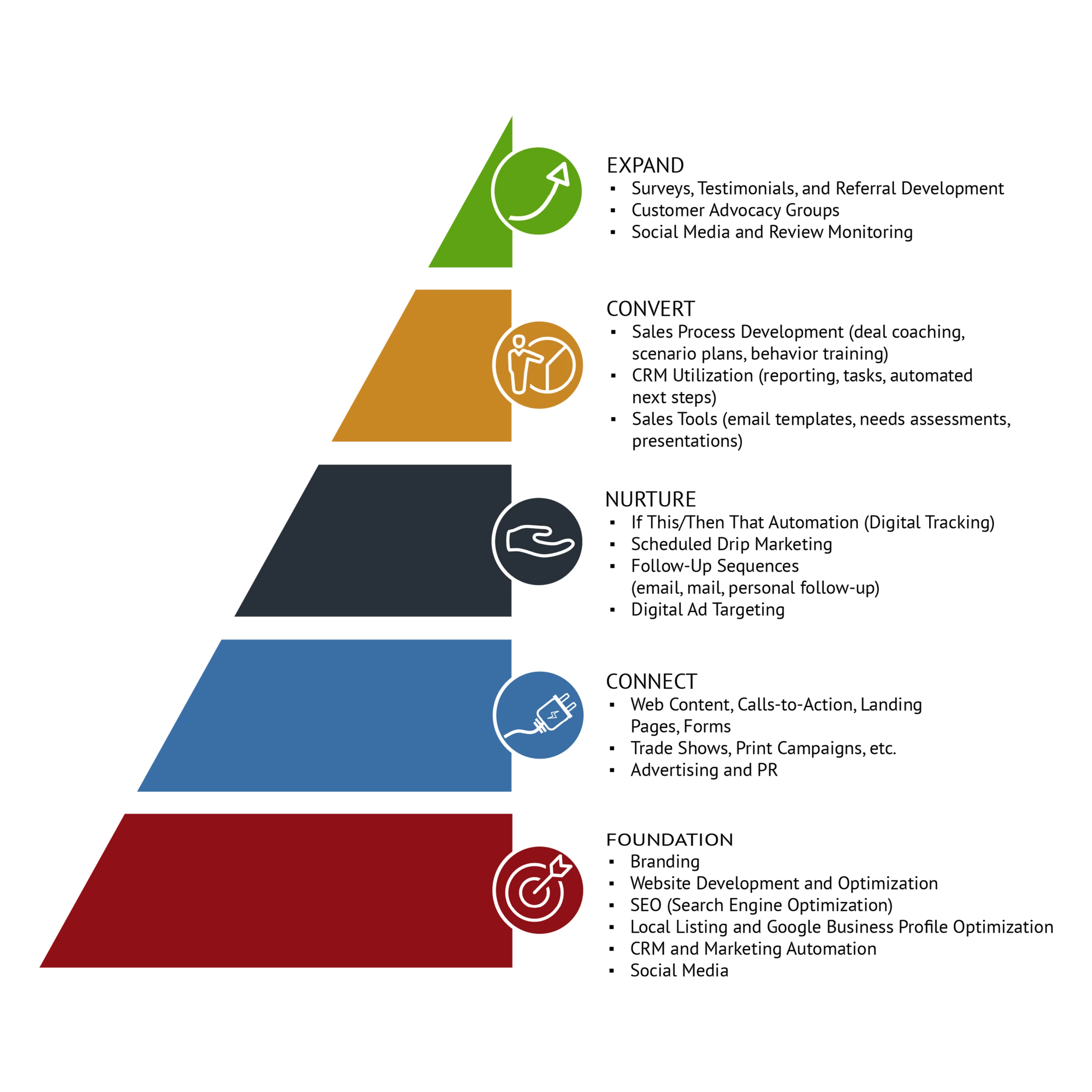3-Step Guide to Developing a Strategic Marketing Plan
 Continuous shifts in today’s business environment pose major financial threats to companies that do not prioritize developing a strategic marketing plan. Organizations that avoid planning for the future by establishing SMART goals often find themselves trapped in the cyclical stagnation of their business operations. Usually, businesses that bypass strategic planning are unable to remain competitive. Any marketing pursuits from organizations that haven’t built their foundation around effective communication, a defined position in the market, and established goals will end up spending money that they don’t have on initiatives that rarely turn a profit.
Continuous shifts in today’s business environment pose major financial threats to companies that do not prioritize developing a strategic marketing plan. Organizations that avoid planning for the future by establishing SMART goals often find themselves trapped in the cyclical stagnation of their business operations. Usually, businesses that bypass strategic planning are unable to remain competitive. Any marketing pursuits from organizations that haven’t built their foundation around effective communication, a defined position in the market, and established goals will end up spending money that they don’t have on initiatives that rarely turn a profit.
Conversely, organizations that envision their future tend to look through the lens of innovation AND strategy to develop the skills, structures, and processes needed to generate value and create a sustainable advantage. Roger Martin, the author of The Design of Business, refers to the dynamic interplay of analytical mastery (strategy) and intuitive originality (innovation) as design thinking. Design-thinking organizations quickly pivot in response to changing markets and economic conditions, enabling them to achieve massive scale and efficiency.
Spearhead’s 3-step Approach to Strategic Planning
If you’re stuck in a repetitive cycle and unsure where to focus your marketing efforts, it’s time to go back to the drawing board. With the following tips and strategies, you can begin to align your marketing efforts with your organization’s purpose for existence, its position in the market, and your envisioned future.
Step 1: Find Your Purpose – What drives your Strategic Marketing Plan?
During vulnerable times, some companies compromise their core values for short-term gains. These compromises leave the team disengaged and misaligned with the organization’s envisioned future. However, when energized with a steadfast purpose and core values, a strategic marketing plan directs stakeholders and enables them to make appropriate decisions. It’s time to define your organization’s purpose clearly by defining your mission, vision, and values. In addition, make sure to write down your mission, vision, and values statements and share them with your staff! Ask yourself the following questions:
- Mission – What do we want to accomplish?
- Vision – How do we want to accomplish it?
- Values – What will we never compromise in doing so?
Answer the following questions thoughtfully and communicate with your stakeholders exactly why your business exists, what you would like to achieve, and the fundamental beliefs you prioritize. When your team’s actions align with your purpose for existence, your team can better communicate your brand’s story to your consumers, ultimately increasing customer satisfaction and driving brand advocacy.
Jim Collins, former Stanford Business School professor and author, suggests that a good expression of a company’s core purpose should possess these five essential characteristics: (1) it positively inspires your employees, (2) it must be as valid 100 years from now as it is today, (3) it should help you think expansively about opportunities present, (4) it should show what not to do, and (5) it should be truly authentic to your organization. Check out Jim Collins’s blog here to learn more about determining your company’s core purpose! Watch your employee’s behaviors and your organization’s culture improve as you consciously support a positive and productive environment.
Step 2: Position Yourself Strategically – What is your competitive advantage?
When marketing a product or service, remember that you cannot be everything to everyone. If you try to have great solutions to everyone’s problems, you will dilute your marketing efforts and burn through your budget. Avoid spreading your organization’s marketing efforts too thin by crafting a competitive positioning statement to supplement your strategic marketing plan. Douglas Stayman, Associate Dean of Cornell University, defines the positioning statement as a concise description of your target market and a compelling picture of how you want that market to perceive your brand. It can be described as an internal tool for stakeholders to reference when making product and marketing decisions. Your positioning statement ensures each decision aligns with and supports its envisioned future.
There are multiple ways to approach writing a positioning statement. Through our experience, Spearhead has found it most beneficial to begin the process by assessing your existing position, conducting industry research, and interviewing stakeholders. You aim to gather a 360-degree view of your business and its competitive landscape.
Conduct a competitive analysis
Vitalize your industry research by conducting a competitive analysis to identify major competitors and discover what strategies have aided their financial success. A simple Google search of the type of products and services your company offers will help determine a few major players going after the same group of qualified leads. Another option to arm yourself with the intelligence of industry trends and unsuspecting competitors is to use online tools such as SEMrush to discover competitors’ rankings for similar keywords. Also, look at your competitors’ digital strategies for display advertising, organic and paid search, and link building. Please note whether your competitors share their published content with social media networks, what social platforms they actively use, and what types of audience(s) they engage with. 
After determining your competition, analyze their position and compare their digital presence. Study the different types of content your competitors publish, what mediums they publish on, the frequency in which it is updated, and the topics they discuss. If your competitors publish to a blog, analyze the SEO structure of their content and the keywords used to generate additional website traffic. With SEMrush, you can quickly analyze your competitors’ best-performing keywords and how you stack up against them. Use the knowledge you gather from your research to help you identify areas for improvement within your organization.
Defining your target market
Your task is to narrow your focus to expand your reach by identifying a specific target market. Yes, you heard that right! Targeting a particular market doesn’t necessarily mean losing out on customers who don’t fit your criteria. Instead, identifying a target market allows you to focus your brand’s message and marketing dollars on reaching a more specific audience. Choose a target audience that is more likely to convert into customers! Don’t rush this process; instead, get inspired by studying your competitors’ audience groups to identify an unexploited niche that your competition has overlooked. Identify groups of people who observe the most value from your offering’s features and benefits, and don’t be afraid to be specific by listing target demographics and psychographics, too! Once you have a clear understanding of your ideal target market, ask yourself the following:
- Relevant—Is your offering relevant to a specific target market’s pain points, and does it deliver a practical solution that is difficult for competitors to replicate?
- Reachable – Through what means are you able to reach this target audience? Do you have a contact list? Motivated referral sources? Advertising channels?
- Right-Sized – Are there enough of these prospects to foster profitable relationships? Is there a limited number of competitors?
Craft your positioning statement
The information gathered above will aid you in crafting a strategic positioning statement that defines your organization’s specific niche within its sphere of influence. When crafting your positioning statement, remember that it should add value to and positively influence the perceptions of your chosen target market relative to your organization’s competitors. Your positioning statement should simplify who your company is the audience you want to reach, the value your organization offers, and why someone ought to care. Now, implement your positioning statement throughout your company to drive consistency for your brand’s identity, a cohesive buyer’s experience, and the development of SEO-optimized content for your website.
Step 3: Define Your Envisioned Future – What are your strategic marketing goals?
At this point in the strategic planning process, you’ve assessed your positioning in the marketplace. By now, you should also have a well-rounded understanding of the organization’s core values and purpose for existence. When developing a strategic marketing plan, the next component to consider is defining your ‘Envisioned Future’ and determining a growth strategy to achieve your Big Hairy Audacious Goals (BHAG). We use our re-envisioned sales funnel to assess where to apply pressure in a sales and marketing program and set our goals and KPIs.
It’s important to remember that this is a continuous cycle. While it is helpful to stage contacts by terms like “suspect,” “lead,” “prospect,” and “client” in your CRM, the buyer journey is fluid, meaning a person can be in more than one phase at a time for different projects or product needs.
- Identify specific people.
- Connect with them through inbound and outbound tactics, including advertising, trade shows, open houses, web marketing, social media, etc.
- Nurture the relationship by staying in touch with personalized buyer-journey resources.
- Convert opportunities to quotes and quotes to orders.
- Expand by growing customers and working referrals.
BHAG goal-setting
BHAG is a goal-setting term originally coined by Jim Collins and Joe Perras in their book Built To Last: Successful Habits of Successful Companies. A BHAG is a long-term goal (10-25 years) connected to your marketing strategy and influenced by your core values and purpose. Recognize that your BHAG will be the catalyst that stimulates progress and drives innovation within your organization. Consider two things as you establish your BHAG: First, your BHAG should be so audacious that it takes you and your employees out of your comfort zones and creates momentum to increase performance. Second, it should be feasible enough to conform to the ‘SMART’ parameters and identify a focal point for employee efforts.
SMART goal-setting
As mentioned above, your BHAG should be constructed using the ‘SMART’ framework. This means your goal(s) should be Specific, Measurable, Actionable, Realistic, and Timely. Structuring your BHAG as a SMART goal allows you to strategize your organization’s time and resources productively, establish habits to achieve operational efficiency, and measure your progress using Key Performance Indicators (KPIs). Improve the likelihood of accomplishing your goals by writing them down! Psychology professor Gail Matthews confirms the importance of writing down goals in a study she conducted at the Dominican University of California. Empirical evidence shows that students who wrote down their goals were 43% more successful in achieving them than those who kept their goals to themselves without writing them down. Finally, communicate these goals with your team and work collectively to realize your vision!
Conclusion
Developing a strategic marketing plan isn’t for the faint of heart. However, if you’re a part of a company that strives to streamline business operations, evaluate progress along the way, and influence market penetration – it’s for you! If you’re tired of spending your marketing budget on unprofitable initiatives, it is for you, too! Bring clarity to your organization’s purpose for existence, position in the market, and your envisioned future by following the tips and strategies described above!



